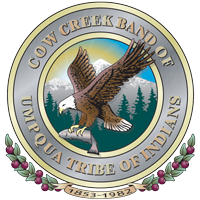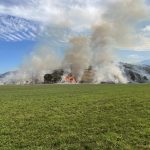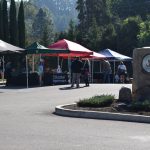Cow Creek and NRCS Partner to Find Solutions for Healthier Forests
Up the Tiller Trail Highway, a forest rehabilitation project is taking shape that could transform the landscape for generations to come.
The Cow Creek Umpqua Tribe is partnering with the Natural Resources Conservation Service (NRCS) of the U.S. Department of Agriculture to restore and strengthen the forest, returning it to a steady state of health and making it more resilient to wildfires and disease.
Within the Elk Creek Watershed, the Cow Creek Band of Umpqua Tribe of Indians owns about 10,000 acres – just a portion of ancestral homeland that the Tribe has bought back over the years after the involuntarily termination of all rights and lands in 1954.
The lands of the Elk Creek Watershed are significant to the Tribe in many ways.
“There are a lot of important cultural, traditional, spiritual, archaeological areas within this Elk Creek Watershed. It’s a very important place,” says Tim Vredenburg, Cow Creek Director of Forest Management. “It’s also an area that the Tribal members hunt a lot. We’re restoring some important deer and elk habitats that have degraded badly over the years.”
The Elk Creek Watershed wasn’t always in bad shape. It has changed in the last several hundred years, evolving from an oak savannah and meadow into conifers and dense brush. Over time the ability of wildlife to flourish has diminished, and now the area is in need of help.
“This forest, along with the forests along the Western states, is severely overstocked, diseased, and there’s not enough diversity in some of these thick stands,” says David Ferguson, District Conservationist with the NRCS.
In addition to the health of the forest, every day brings an increased risk of wildfires. Within last 20 years, over 50% of the Tiller Ranger District has been lost to fire, and many of the areas have burned two or three times.
“After decades of watching lands burn and succumb to catastrophic wildfire, [Tribal leadership] really became interested in managing the whole landscape for forest health,” says Vredenburg.
Working together, Cow Creek and the NRCS have spent the last three years clearing underbrush, and thinning thick stands of Douglas fir across the Elk Creek Watershed. The next phase of rehabilitation and conservation involves reintroducing prescribed burns to the area.
This adoption of a fire-resilient model of forest management is something more experts are turning to, but it’s also an Indigenous approach that Tribes have been using for centuries.
“People are beginning to be more comfortable with the idea of underburning,” says Vredenburg, “Not only because of its use historically, but because catastrophic wildfires are expensive.”
“With the underburning, we’ll see more of the diversity come back,” says Ferguson.
Before fire is reintroduced, Ferguson and Vredenburg agree that there’s a lot more work and fuels reduction that must wrap up to prepare the land. Depending on weather and fire conditions, they estimate the first prescribed burns could happen as soon as this fall, or as late as next year.
“We’re losing entire communities to wildfire. Everyone is being driven to really think more seriously about how we address the issue,” says Vredenburg.
When the Elk Creek Watershed project is completed, NRCS and Cow Creek both see opportunities to carry over the holistic method of forest management, rehabilitation and burns to other forests in the region.
“This Tribe has the wherewithal within this community, so this is going to literally light a fire under some other people to start managing their land,” says Ferguson.






